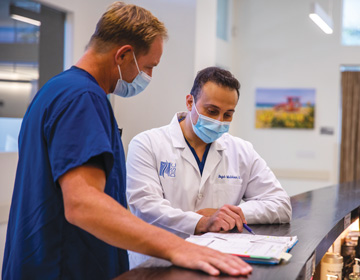“They can very easily remove the device 10 to 12 days after surgery,” says Dr. Cole. “They do it with the help of video instructions we link them to or with written directions we send them home with.”
Of course, this is only one of the ways in which wound care has evolved. Let’s look at what’s new in the world of closure techniques — and how best to decide which method will work best at your facility.
• Alternative closure devices. When dealing with non-traumatic surgical wounds, surgeons can opt for traditional closing methods — sutures, staples, glues and tapes — but there are several inherent advantages to more
non-invasive options, including improved healing and faster closing times. In addition to allowing his patients to do away with the post-op suture removal visit, the closure device Dr. Cole has been using for approximately two years provides
several key benefits.
“The device is clear, so patients can see covered wounds and watch for complications as they heal,” he says. “It also has small drainage holes, so patients can remove excess fluid from the wound if need be.”
The device includes antibacterial components, and significantly reduces the amount of time it takes Dr. Cole to close wounds. “There’s some data that shows it can reduce normal closing time by one-third,” he says. “There
are definitely some economic advantages to using it, particularly in terms of OR efficiencies for busy surgery centers.”
Rojeh Melikian, MD, a board-certified orthopedic spine surgeon at DISC Sports & Spine Center in Newport Beach, Calif., sees a host of benefits afforded by the various devices that rely on adhesive strips, adhesive combinations or plastic
strips to pull surgical wounds closed. He also acknowledges that the devices are associated with certain limitations, depending on the wound in question. “The most common mistake is trying to apply adhesive strips or skin glues to
wounds that have high tension,” he says. “These wounds will likely overwhelm the adhesive strips and pull apart.”
Such wounds, advises Dr. Melikian, are better handled by first using sutures to pull the skin together, which eliminates most of the tension, then finishing the job with adhesive strips.
• Antibacterial irrigation options. Surgeons can treat wounds at the end of surgery with antibiotic or antimicrobial irrigation solutions to remove debris and contaminants from the area and reduce the risk of surgical site infections.
There are many different antibiotics that can be placed in wound irrigation solutions — such as bacitracin, cefazolin and vancomycin — and these solutions can be tailored to the specific type of surgical wound and the bacteria
that’s most likely to be an issue.
Good wound closure practices go a long way toward ensuring positive long-term outcomes of surgery.
— Rojeh Melikian, MD
Whether surgeons use sutures, staples or an alternative closure device, irrigating the wound is a key step that should be added to their surgical routines. “Prior to closure, the surgical wound should be flushed,” says Dr. Melikian.
• Antibacterial dressings. In addition to using irrigation solutions and alternative closure devices, wound care can be improved by applying dressings with antibacterial components built directly into them. “These are interesting
options,” says Dr. Cole. “They can include silver or alternatives to silver that promote healing.”
However, as he points out, these dressings are a bit controversial in terms of their net effect on wounds. Some data even suggest the dressings offer no benefit when used on clean or closed surgical incisions.
.svg?sfvrsn=be606e78_3)

.svg?sfvrsn=56b2f850_5)